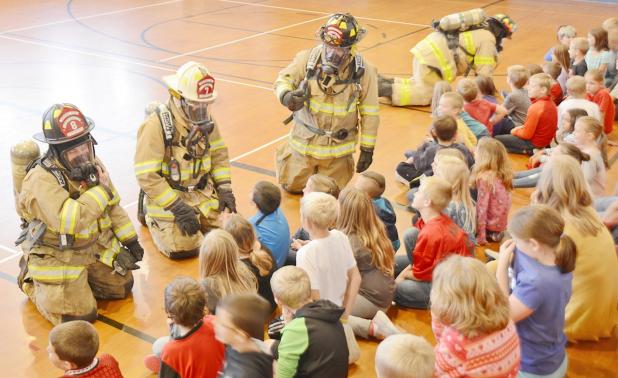
www.johnsonpublications.zenfolio.com Brooke Robertson | Johnson Publications
Members of the Grant Volunteer Fire Department visited Perkins County Elementary on Friday, Oct. 12 during Fire Prevention Week to teach students about fire safety.
Look. Listen. Learn. Be aware. Fire can happen anywhere.
The latest statistics from the National Fire Protection Association (NFPA) show if someone has a reported fire in their home, they are more likely to die today than they were a few decades ago.
This startling statistic is behind this year’s Fire Prevention Week theme: “Look. Listen. Learn. Be aware - fire can happen anywhere.”
Fire Prevention Week took place last week, Oct. 7-13, across the nation.
Through three simple calls-to-action, this year’s theme identifies basic but essential ways people can reduce their risk to fire and be prepared in the event of one:
Look for places fire can start. Listen for the sound of the smoke alarm. Learn two ways out of each room.
“People take safety for granted and are not aware of the risk of fire,” said Lorraine Carli, NFPA vice president of outreach and advocacy.
This year’s message applies to virtually all locations. However, NFPA continues to focus on home fire safety, as the majority of U.S. fire deaths (four out of five,) occur at home each year. In fact, the fire death rate (per 1,000 home fires reported to the fire department) was 10 percent higher in 2016 than in 1980.
“While we’ve made significant progress in preventing home fires from happening, these statistics show that there’s still much more work to do when it comes to teaching people how to protect themselves in the event of one, and why advance planning is so critically important,” said Carli.
Fire Prevention Week is the longest running public health and safety observance on record. It was established in 1922 following the Great Chicago Fire that killed hundreds and left hundreds of thousands homeless.
Here are safety tips from the NFPA:
• Draw a map of the home with all members of the household, marking two exits from each room and a path to the outside from each exit.
• Practice a home fire drill twice a year. Conduct one at night and one during the day with everyone in the home, and practice using different ways out.
• Teach children how to escape on their own in case they can’t be helped.
• Make sure the house number is clearly marked and easy for the fire department to find.
• Close bedroom doors—this may slow the spread of smoke, heat and fire.
• Once everyone is out, stay out. Never go back inside a burning building.
• Smoke alarms should be installed throughout the home including the kitchen, basement, and every bedroom and outside sleeping area.
• Never remove or disable smoke alarms.
• Test smoke alarms at least once per month by pushing the test button.
• Interconnect smoke alarms so if one sounds, they all do.
• If smoke alarms don’t work, replace the correct size battery or the entire smoke alarm unit.
• Don’t let children play with fire.
• Don’t leave cooking items or clothing irons unattended.
• Place a portable ladder in each second-floor room.
• Have an updated, emergency first aid kit.
• Check fire extinguishers for expiration and replace as needed.
• Handle gasoline or propane-powered equipment cautiously.
• Install carbon monoxide detectors.
Visit http://www.nfpa.org/public-education/campaigns/fire-prevention-week-audi... for more about fire safety.
